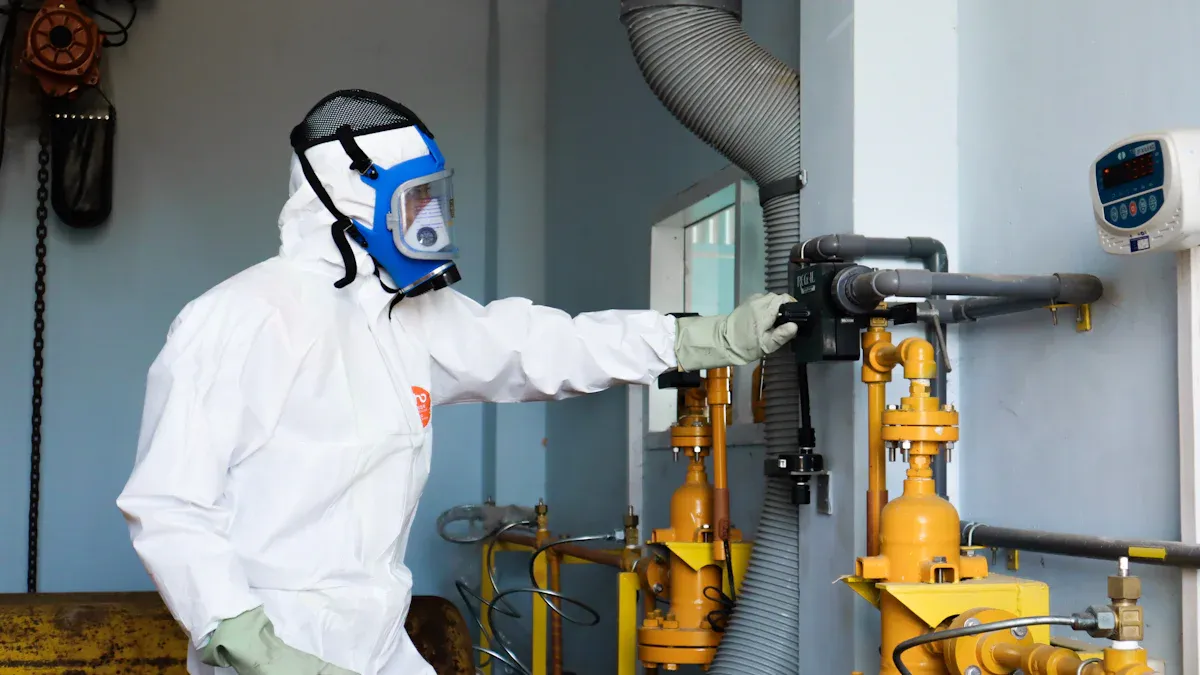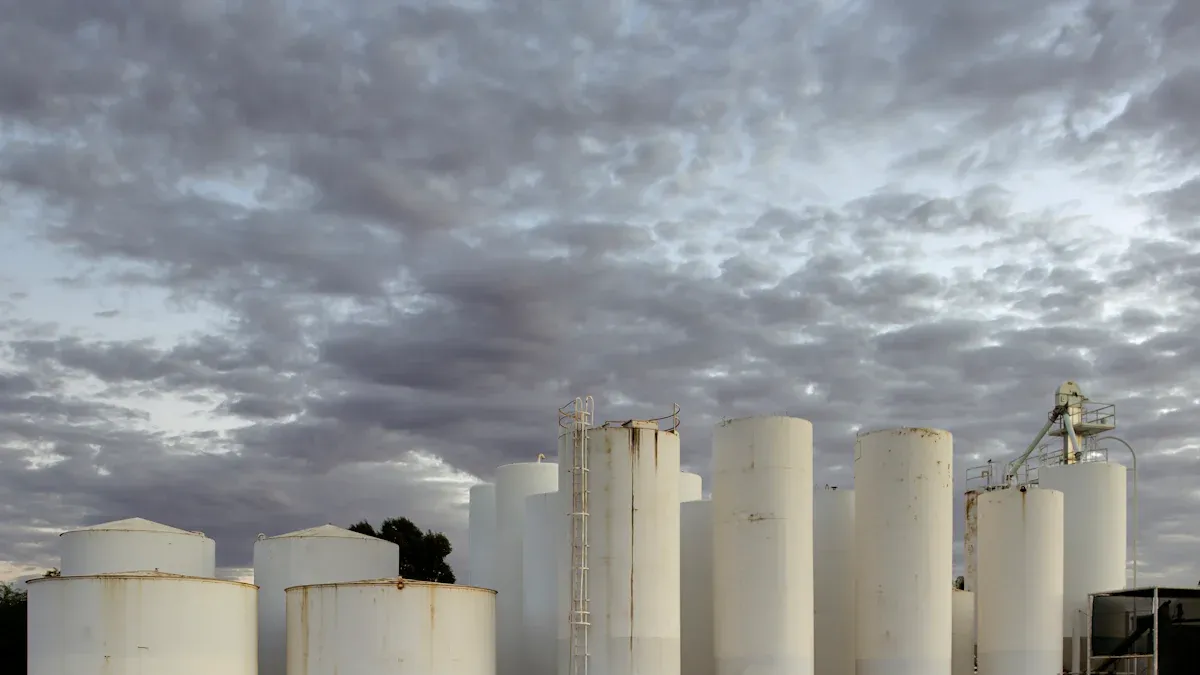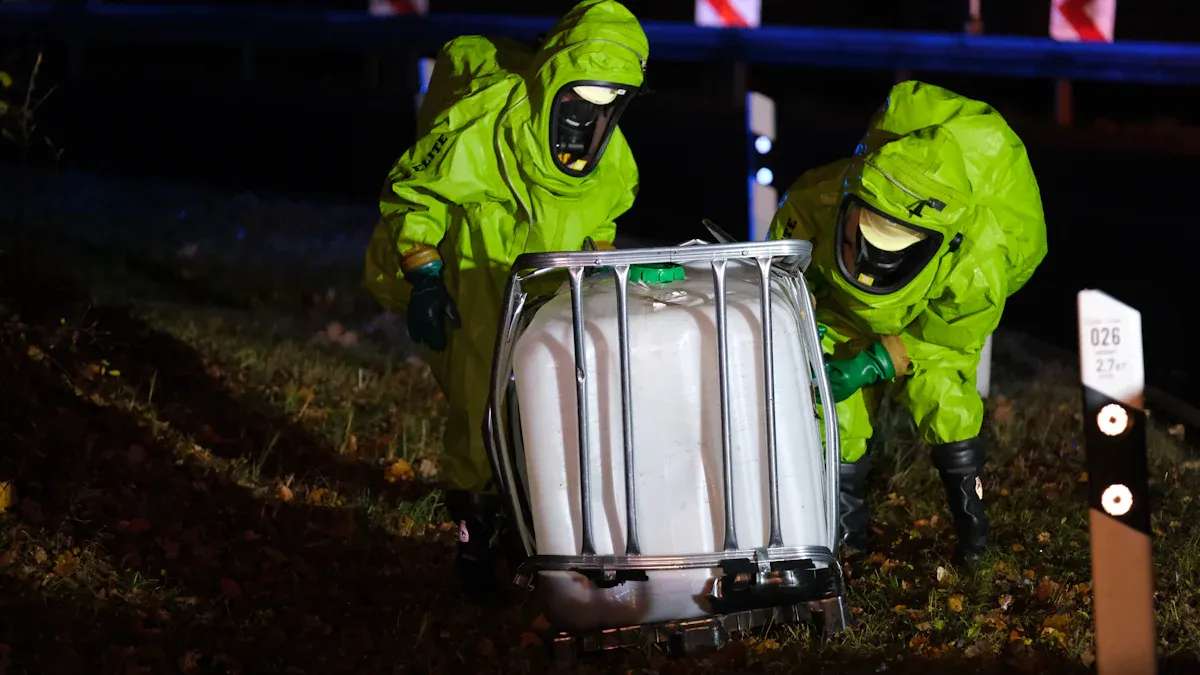Views: 0 Author: Site Editor Publish Time: 2025-09-23 Origin: Site










You can store Calcium Hydride safely in 2025 by following three simple steps:
Wear personal protective equipment (PPE) such as a flame-resistant lab coat, gloves, and goggles.
Place the material in a cool, dry, and well-ventilated area, away from water and ignition sources.
Prepare for emergencies by knowing spill cleanup and exposure procedures.
Always follow these steps to protect yourself and your workspace.
You should choose a storage area that keeps Calcium Hydride safe from moisture and heat. Select a spot away from sinks, windows, and any water sources. Place the containers on shelves that are sturdy and not near the floor. This helps prevent accidental spills and keeps the chemical away from flooding or leaks.
Good airflow is essential in your storage area. Install a ventilation system that moves air out of the room and reduces the buildup of hazardous vapors. Use exhaust fans or fume hoods if possible. You lower the risk of dangerous reactions by keeping the air fresh and dry.
Tip: Always check that your ventilation system works before storing Calcium Hydride. Poor ventilation increases the risk of exposure and chemical accidents.
When you transfer Calcium Hydride, work slowly and carefully. Use tools that do not spark or react with the chemical. Always keep the material in closed, airtight containers. If you need to neutralize Calcium Hydride, add it slowly to a large volume of water in a well-ventilated area. Never rush this process, and never use small amounts of water. You can also use long chain alcohols for neutralization.
To prevent exposure, follow these steps:
Keep Calcium Hydride in sealed containers.
Avoid direct contact with water or water vapor.
Store and handle the chemical away from ignition sources.
Use proper PPE every time you work with the material.
You protect yourself and others by following these rules. Exposure can cause burns, fires, or toxic reactions.
Wear a flame-resistant lab coat when handling Calcium Hydride. Choose coats made from treated cotton or flame-resistant fibers. Remove the coat quickly if you spill chemicals on it.
Use gloves that protect against chemicals and fire. Wear Nomex gloves between two pairs of nitrile gloves for extra safety. Do not use gloves made from polyester or other synthetic fabrics.
Put on fully enclosed safety goggles or a face shield. Goggles protect your eyes from splashes and vapors. Choose goggles that fit well and cover your eyes completely.
Protective Equipment | Description |
|---|---|
Flame Retardant Lab Coats | Made from flame-resistant fibers or treated cotton, these coats protect against flammable materials and pyrophoric substances. Remove quickly if splashed with chemicals. |
Nitrile/Neoprene Gloves | Chemically resistant gloves protect your skin from toxic or corrosive materials. Use them to handle hazardous substances safely. |
Safety Goggles | Goggles offer strong eye protection against corrosive chemicals and splashes. They come in different types for various hazards, including vapors and impacts. |
Note: Always wear long pants and closed-toe shoes in the lab. Avoid synthetic fabrics, which can melt or catch fire.

You need to choose the right containers to keep Calcium Hydride safe. Use a waterproof double container to prevent any contact with moisture. Place the main container inside a secondary one that can catch leaks or spills. Store the containers in a normal chemical storage cabinet, away from water sources and heat. This setup helps you avoid dangerous reactions.
Waterproof double containers protect against leaks.
Normal cabinets keep chemicals organized and secure.
Always have a Type D fire extinguisher nearby for emergencies.
Make sure you seal each container tightly. Check the lids for cracks or damage before use. Airtight seals stop moisture from getting inside. You should never leave containers open, even for a short time. If you notice a loose lid, replace it right away.
Tip: Label each container with the date you sealed it. This helps you track storage time and spot old containers.
Store Calcium Hydride in a cool place. High temperatures can increase the risk of chemical reactions. Keep the storage area below 25°C (77°F) if possible. Avoid direct sunlight and heat sources. Use a thermometer to monitor the temperature regularly.
Humidity can affect the stability of Calcium Hydride. High humidity increases the chance of a reaction with water vapor. You should keep the storage area as dry as possible. Use a dehumidifier if needed.
Condition | Result | Implication |
|---|---|---|
80% Humidity at 30°C | Hydrogen yield of 726 mL g−1 after 5 hours | Stability can be maintained in humid conditions, but caution is needed. |
Note: Even though Calcium Hydride can stay stable in humid air for a short time, you should always aim for low humidity to reduce risks.
Label each container according to chemical safety standards. Use clear, waterproof labels that list the chemical name, hazard class, and date. The hazard class for Calcium Hydride is 4.1 to 4.3, which covers solids that are flammable, dangerous when wet, or spontaneously combustible.
Class or Division No. | Name of Class or Division and Examples |
|---|---|
4.1 to 4.3 | Solids that are flammable, spontaneously combustible, or dangerous when wet (e.g., calcium hydride) |
Keep a logbook or digital record of all Calcium Hydride containers. Write down the date of storage, container condition, and inspection results. Update your records after each inspection or when you move a container. Good record-keeping helps you track chemical age and spot problems early.
Always review your records before handling or moving Calcium Hydride. This habit keeps your storage safe and organized.
You should inspect your storage area for calcium hydride at least once a week. Start by looking at each container. Check for cracks, dents, or signs of corrosion. Make sure the labels are clear and easy to read. If you see any powder or residue around the lids, this could mean a leak. Look at the shelves and floor for spills or dust. Use a flashlight to check dark corners and behind containers. If you find anything unusual, report it right away.
Tip: Keep a checklist for each inspection. Mark off each item as you go. This helps you stay organized and ensures you do not miss any steps.
Plan a full audit of your storage area every three months. During an audit, review your inspection records and compare them with the actual condition of your storage. Check that all containers match your logbook entries. Make sure you have not missed any expired or damaged containers. Confirm that your ventilation system works and that emergency equipment, like fire extinguishers, is in place. Audits help you catch problems before they become serious.
You need to recognize the signs of degradation in calcium hydride. If you see a change in color, such as darkening or yellowing, this may mean the chemical has reacted with air or moisture. Watch for clumping or a gritty texture, which can signal that the material has absorbed water. If you notice a strong odor or see gas bubbles inside the container, act quickly. These are signs that the chemical is breaking down and could become dangerous.
Leaks can happen if a container gets damaged or if the seal fails. Look for white powder or crust around the lid. This often means the chemical has escaped. If you hear a hissing sound or see vapor, move away and alert your supervisor. Never touch a leaking container with bare hands. Always use proper PPE and follow your lab’s emergency procedures.
Hazard Type | Description |
|---|---|
Reactivity Alerts | Strong reducing agent, water-reactive, air-reactive. |
Air & Water Reactions | Ignites in air or reacts violently with high humidity; generates flammable hydrogen gas with water. |
Fire Hazard | Produces flammable gases on contact with water; may ignite on contact with water or moist air. |
Health Hazard | Inhalation or contact may cause severe injury or death; produces corrosive solutions with water. |
Note: Always treat any sign of a leak or degradation as a serious hazard. Quick action can prevent accidents and keep your lab safe.

If you spill calcium hydride, you must act quickly and safely. First, put on your PPE: lab coat, gloves, and goggles. Keep others away from the spill area. Never use water to clean up calcium hydride. Water can cause a violent reaction and release flammable hydrogen gas.
Follow these steps to clean up a spill:
Use a dry, non-sparking tool such as a plastic scoop or brush.
Gently sweep the spilled material into a clean, dry, and labeled container.
Avoid creating dust or spreading the material.
Ventilate the area by turning on exhaust fans or opening fume hoods.
Place the waste container in a designated hazardous waste area.
Tip: Always keep a spill kit designed for water-reactive chemicals nearby. This kit should include dry sand, non-sparking tools, and extra PPE.
You must dispose of calcium hydride waste as hazardous material. Seal the collected waste in an airtight, labeled container. Store it away from water and heat sources until a certified hazardous waste handler can collect it. Never throw calcium hydride in regular trash or pour it down the drain.
Contact your facility’s hazardous waste coordinator for pickup.
Record the spill and disposal in your chemical logbook.
Follow all local and federal regulations for hazardous waste.
If you or someone else gets exposed to calcium hydride, respond immediately. For skin contact, brush off any dry material before rinsing with large amounts of water. Remove contaminated clothing right away. For eye contact, rinse eyes with water for at least 15 minutes and seek medical help. If you inhale dust or fumes, move to fresh air and get medical attention.
Alert: Never delay treatment. Calcium hydride can cause severe burns and breathing problems.
You must report all exposure incidents, even if they seem minor. Notify your supervisor and fill out an incident report form. Facilities that store large amounts of hazardous chemicals must follow strict reporting rules. In 2025, the reporting deadline for exposure incidents is March 1. However, laboratory research chemicals are exempt from Tier II reporting.
Here is a summary of the reporting requirements:
Requirement | Details |
|---|---|
Reporting Deadline | March 1, 2025 |
Applicable Facilities | Those possessing hazardous chemicals above reporting thresholds in 2024 |
Reporting Thresholds | 500 pounds for Extremely Hazardous Substances (EHS) or 10,000 pounds for any hazardous chemical |
Exemptions | Laboratory research chemicals are exempt from Tier II reporting |
Keep accurate records of all incidents. Review your emergency procedures with your team after every event. This helps you improve safety and prevent future accidents.
You must follow strict safety standards when storing calcium hydride in 2025. Regulatory agencies have updated their rules to protect you and the environment. The Environmental Protection Agency (EPA) in the United States now requires you to use safer storage methods and eco-friendly containers. You need to keep calcium hydride away from water and ignition sources at all times. French and European Union authorities also demand careful handling and clear safety protocols. You should check your local regulations before you set up your storage area.
Always review the latest guidelines before you order or store calcium hydride. Rules can change each year.
Here is a summary of the latest regulatory updates for calcium hydride storage:
Region | Regulatory Update |
|---|---|
United States | EPA mandates stricter standards for handling and storage. You must use improved compliance protocols and eco-friendly methods. |
France | French and EU authorities require strong safety protocols and careful documentation for handling and storage. |
You need to keep detailed records for every container of calcium hydride. Write down the date you received the chemical, the condition of the container, and each inspection result. Update your logbook after every audit or incident. Good documentation helps you prove compliance during inspections. You should store your records in a safe place, either digitally or in a locked cabinet.
Record the chemical name, hazard class, and storage location.
Note the date of each inspection and any problems found.
Keep copies of training certificates for all staff.
Tip: Use a digital logbook to make updates easy and reduce errors.
You must train every staff member who works with calcium hydride. Training should cover proper handling, PPE use, emergency procedures, and spill cleanup. You need to show each person how to recognize hazards and report incidents. New employees should complete training before they start work. Experienced staff should review safety rules regularly.
Teach staff how to use PPE correctly.
Show them how to inspect containers and spot leaks.
Practice emergency drills at least twice a year.
You should renew staff certifications every year. Regulations now require annual training updates to keep everyone safe. You need to schedule refresher courses and document each session. Certification renewal helps you stay compliant and reduces the risk of accidents.
Note: Regular training keeps your team ready for emergencies and ensures you meet all legal requirements.
By following these compliance steps, you protect your lab and meet the latest safety standards for calcium hydride storage in 2025. Stay informed about regulatory changes and invest in ongoing training for your staff.
You must choose the right containers for calcium hydride. Many people make the mistake of using containers that do not seal tightly or resist moisture. If you leave calcium hydride in an open jar or a container with a damaged lid, you increase the risk of leaks and dangerous reactions. You should never use glass containers with cracks or plastic that can melt. Always select containers made for hazardous chemicals. Double containment adds another layer of safety.
Tip: Place each container inside a secondary waterproof bin. This step helps you catch leaks before they become a problem.
Common container mistakes to avoid:
Leaving calcium hydride on the bench after use
Using containers with loose or broken lids
Storing in containers not rated for hazardous materials
Placing containers near water sources or heat
Proper labeling keeps you and your team safe. If you forget to label a container or use unclear handwriting, you risk confusion and accidents. You must use waterproof labels that show the chemical name, hazard class, and date. Never reuse old labels or rely on memory.
A real-life accident shows why labeling matters. A researcher grabbed a container labeled 'isopropanol' but it actually held concentrated nitric acid. The mix caused a chemical reaction and led to acid burns. The researcher needed emergency medical care. This incident highlights how improper labeling can cause injuries and dangerous reactions.
Consequences of improper labeling:
Chemical mix-ups
Accidental exposure
Serious injuries
Emergency medical situations
Mistake | Risk Level | Result |
|---|---|---|
Unlabeled containers | High | Chemical confusion, accidents |
Wrong labels | High | Dangerous reactions |
Faded labels | Medium | Unclear identification |
Regular inspections keep your storage area safe. If you skip inspections, you may miss leaks, damaged containers, or expired chemicals. You should check each container for cracks, corrosion, or powder around the lid. Weekly visual checks and quarterly audits help you spot problems early.
Note: Use a checklist for every inspection. Mark each item as you finish. This habit helps you stay organized and thorough.
You must pay attention to warning signs. If you see color changes, clumping, or gas bubbles in a container, act quickly. Ignoring these signs can lead to fires, toxic releases, or explosions. Always report any unusual sights or smells to your supervisor.
Common warning signs include:
White powder or crust near lids
Hissing sounds or visible vapor
Strong odors
Changes in chemical texture or color
If you notice any of these, do not touch the container. Put on your PPE and follow emergency procedures. Quick action prevents accidents and keeps your lab safe.
�� Always treat warning signs seriously. Your attention protects everyone in the lab.
You can store calcium hydride safely by following three easy steps:
Wear the right PPE every time.
Store the chemical in a cool, dry, and well-ventilated area.
Know what to do in an emergency.
Stay up to date with safety training and review your lab’s procedures often. Regular practice and careful attention help you keep your lab safe and compliant.
Move away from the area. Water reacts with calcium hydride and releases flammable hydrogen gas. Alert your supervisor and follow your lab’s emergency procedures. Never try to clean it up with water.
You should never store calcium hydride near acids or bases. These chemicals can react and cause dangerous situations. Always keep calcium hydride in a separate, labeled storage area.
Inspect your containers at least once a week. Look for leaks, corrosion, or damaged labels. Keep a checklist to track your inspections and catch problems early.
PPE Item | Purpose |
|---|---|
Lab Coat | Protects your body and clothes |
Gloves | Shields your hands |
Goggles | Guards your eyes |
Always wear all three when handling calcium hydride.
Seal the waste in an airtight, labeled container. Store it in a hazardous waste area. Contact your facility’s hazardous waste coordinator for safe disposal. Never pour it down the drain or throw it in regular trash.
Look for white powder, crust near the lid, or a hissing sound. You may also see vapor or smell something unusual. If you notice these signs, report them right away and avoid touching the container.
Humidity can cause calcium hydride to react and release hydrogen gas. You should keep the storage area dry and use a dehumidifier if needed. This step helps prevent dangerous reactions and keeps the chemical stable.